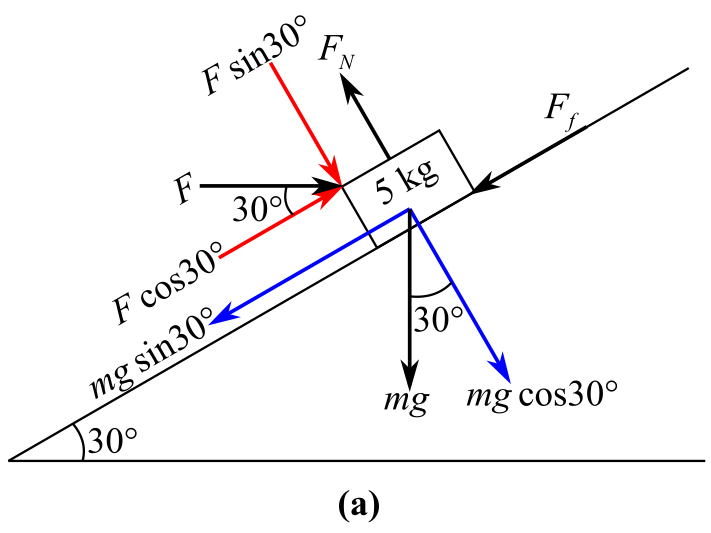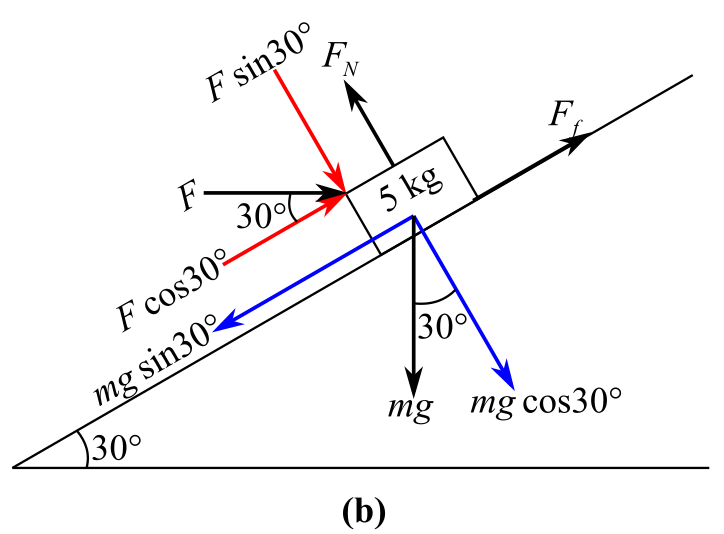
Concept explainers
A 5.0-kg block rests on a
block and the incline is 0.20. How large a horizontal force must push on the block if
the block is to be on the verge of sliding (a) up the incline and (b) down the incline?
(a)
The minimumhorizontal forcerequired to push the
Answer to Problem 81SP
Solution:
Explanation of Solution
Given data:
The mass of the block is
Coefficient of static friction between the block and incline is
Formula used:
The expression of the coefficient of static friction is
Here,
The expression of the force’s equilibrium is
Here,
Explanation:
Draw the free body diagram of the block representing all the forces and their components as shown in the figure below:

Since the block is considered to be on the verge of sliding, the change in velocity is zero, and therefore, the acceleration of the block is zero.
In the above diagram,
Recall the expression of the force equilibrium along y- direction:
Consider the force normal to the incline in upward direction as positive and the force normal to the incline in the downward direction as negative. Hence,
Recall the expression of
Substitute
Recall the expression of the force equilibrium along x- direction:
Consider the force along the incline in right direction as positive and the force along the incline in the left direction as negative. Hence,
Substitute
Further solving the equation for
Conclusion:
The magnitude of the horizontal force required to push the block up the incline is
(b)
The minimum horizontal force required to push the
Answer to Problem 81SP
Solution:
Explanation of Solution
Given data:
Mass of the block is
Coefficient of static friction between the block and incline is
Formula used:
The expression of the coefficient of static friction is
Here,
The expression of the force’s equilibrium is
Here,
Explanation:
Draw the free body diagram of the block representing all the forces and their components as shown in the figure below:

In the above diagram,
Recall the expression of the force equilibrium along x- direction:
Consider the force along the incline in right direction as positive and the force along the incline in the left direction as negative. Hence,
Substitute
Further solving the equation for
Thus,
Conclusion:
The magnitude of the horizontal force required to push the block up the incline is
Want to see more full solutions like this?
Chapter 3 Solutions
Schaum's Outline of College Physics, Twelfth Edition (Schaum's Outlines)
- For the woman being pulled forward on the toboggan in Figure 4.33, is the magnitude of the normal force exerted by the ground on the toboggan (a) equal to the total weight of the woman plus the toboggan, (b) greater than the total weight, (c) less than the total weight, or (d) possibly greater than or less than the total weight, depending on the size of the weight relative to the tension in the rope?arrow_forwardA black widow spider hangs motionless from a web that extends vertically from the ceiling above. If the spider has a mass of 1.5 g, what is the tension in the web?arrow_forwardA boy has stacked two blocks on the floor so that a 5.00kgblock is on top of a1.60kg block. If the coefficient of static friction between the two blocks is 0.400 and the coefficient of static friction between the bottom block and the floor is 0.220,with what minimum force should the boy push horizontallyon the upper block to make both blocks start to slide together along the floor?arrow_forward
- What is the magnitude of the static friction force required to keep a 2.00 kg block resting on an inclined plane at an angle 25 degrees? If the angle was increased, such that the incline plane was steeper, would the magnitude of the static friction force required to hold the block at rest increase, decrease, or stay the same?arrow_forwardA block (mass = 200.00 g) is placed on an inclined plane 45 degrees from the horizontal. The coefficient of static and kinetic friction between the block and the plane are 0.54 and 0.35, respectively. What is the frictional force between the block and the plane?arrow_forwardA dockworker adjusts rope which keeps a ship from drifting alongside a wharf. If he exerts a pull of 200 N on the rope, which has turns of 1 ¼ around the mooring bit, what force T can he support? The coefficient of friction between the rope and the cast-steel mooring bit is 0.30arrow_forward
- A painting with a mass of 20 kg is suspended by two wires from a ceiling. If the wires make angles of 30° and 45° with the ceiling, find the tension in each wire.arrow_forwardThe coefficient of static friction between Teflon and scrambled eggs is about 0.04.What is the smallest angle from the horizontal that will cause the eggs to slide across the bottom of a Teflon-coated skillet?arrow_forwardA ball of weight 200 N is suspended from two cables, one horizontal and one at a 60° angle, as shown. Which of the following must be true of the tension in the angled cable?A. T > 200 N B. T = 200 N C. T < 200 Narrow_forward
- Logs weighing 1.3 kg and 2.2 kg lie on a flat surface and are connected by a rope that breaks at a force of 20 N. The coefficient of friction between the lighter log and the base is 0.50, and between the heavier log and the base 0.30. With what maximum force can we pull the lighter log so that the string does not break?arrow_forwardTwo blocks are connected over a massless, frictionless pulley. Block m1 has a mass of 1.00 kg and block m2 has a mass of 0.400 kg. The angle θ of the incline is 30.0°. The coefficients of static friction and kinetic friction between block m1 and the incline are ?k = 0.400 and ?s = 0.500, respectively. What is the magnitude of the tension in the string?arrow_forwardthe coefficient of static friction between block A and a horizontal floor is 0.320, and the coefficient of static friction between block B and the floor is 0.300. The mass of each block is 2.00kg,and they are connected together by a cord. If a horizontal force F pulling on block B is slowly increased ,in a direction parallel to the connectin cord,until the block start sliding ,what is the magnitude of F at the instant that they start to slide?arrow_forward
 Principles of Physics: A Calculus-Based TextPhysicsISBN:9781133104261Author:Raymond A. Serway, John W. JewettPublisher:Cengage Learning
Principles of Physics: A Calculus-Based TextPhysicsISBN:9781133104261Author:Raymond A. Serway, John W. JewettPublisher:Cengage Learning Physics for Scientists and Engineers: Foundations...PhysicsISBN:9781133939146Author:Katz, Debora M.Publisher:Cengage Learning
Physics for Scientists and Engineers: Foundations...PhysicsISBN:9781133939146Author:Katz, Debora M.Publisher:Cengage Learning College PhysicsPhysicsISBN:9781305952300Author:Raymond A. Serway, Chris VuillePublisher:Cengage Learning
College PhysicsPhysicsISBN:9781305952300Author:Raymond A. Serway, Chris VuillePublisher:Cengage Learning College PhysicsPhysicsISBN:9781285737027Author:Raymond A. Serway, Chris VuillePublisher:Cengage Learning
College PhysicsPhysicsISBN:9781285737027Author:Raymond A. Serway, Chris VuillePublisher:Cengage Learning



